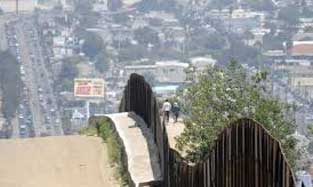
His arrest is by all accounts good news, especially due to Los Rastrojos alleged connections to Joaquin “El Chapo” Guzman, Mexico’s most wanted man and perhaps the world’s most notorious drug lord. Yet Serna’s capture is also a reminder of one of the growing challenges in the seemingly never-ending war on drugs: combating narco subs. Serna headed an organization well known for its ability to rapidly build and use roughly 50-foot-long fiberglass vessels (PDF ), which float just above the waterline, to surreptitiously smuggle drugs across the globe.
Despite concerted efforts by governments to patrol their coastlines, drug traffickers have shown a remarkable ability to adapt, according to experts such as Rear Adm. Joseph L. Nimmich, former commander of the U.S. Coast Guard’s Joint Interagency Task Force South. And over the past five years, drug-trafficking organizations and terrorist groups have increasingly been moving massive amounts of narcotics by way of these vessels. Indeed, U.S. counter-drug officials have estimated that roughly 32 percent of all cocaine sent between Latin America and the United States is transported by way of narco sub.
Historically, each innovation in drug trafficking has come about when existing methods have reached a state of crisis. Early in the drug war, Colombian drug cartels preferred to move their product by small planes, which landed on secret air strips in Central America. American authorities eventually started tracking these planes and closing down the secret airports. During the Miami Vice era, drug traffickers used high-speed boats for transport, but again American authorities caught on. And so in the early ’90s, the narco sub was born.
Over the past few years, law-enforcement officials have received reports that terrorist organizations, such as the FARC in Colombia and the Tamil Tigers in Sri Lanka, have been constructing semi-submersible narco subs to fund their activities. So too have drug-trafficking organizations such as Mexico’s powerful Sinaloa Cartel. And though it hasn’t been reported that al Qaeda and Hizbullah have ever tried to rent space on a narco sub or build one themselves in an effort to move drugs, weapons, or terrorists, it’s not much of a stretch to imagine this development, especially considering the latter’s alleged links to drug traffickers in parts of Latin America.
The reason these vessels are so successful, according to U.S. and Latin American law-enforcement officials, is that they’re difficult to capture. Their hulls are painted dark blue, making them nearly impossible to spot. Powered by ordinary diesel engines, they leave little wake and produce an extremely small radar signature. The DEA claims that roughly 10 percent of all narco subs leaving Latin America are caught, but the true number is probably much lower since crews often sink their craft if they fear they might be discovered.
During the 1990s, American drug-enforcement officials heard of narco subs operating in Central America. In fact, the subs earned the named Bigfoots because some considered them a myth. In 2006, that myth was shattered when U.S. authorities spotted and seized their first vessel. By 2008, they began spotting about 10 a month.
Analysts have estimated that drug-trafficking organizations manufacture more than 120 narco subs every year. The building process, they say, takes anywhere from three months to a year, and costs up to $2 million per sub. The price may be well worth it, though, as these Bigfoots reportedly move as much as 12 tons of cocaine per trip; cut and sold, that translates to up to $4 million.
In an interview with VICE’s VBS TV, former drug trafficker Miguel Angel Montoya said that most narco submarines are made in the Buenaventura Jungle, one of Colombia’s poorest regions and an area that is accessible only by boat. Under the cover of the jungle’s heavy foliage, traffickers are able to hide in plain sight from law enforcement as they carry out their nefarious activities. For access and protection, narco traffickers pay the FARC and other paramilitary groups undisclosed sums, according to Montoya. The traffickers then assign each sub a four-man crew and pay them roughly $40,000 total per voyage.
Semi-submersible subs generally leave Colombia and make their way to drop off their cargo in Mexico, Central America, and the Caribbean. But narco subs have been captured in Honduras, Colombia, Guatemala, Costa Rica, Mexico, and Spain. And some are even rumored to have tried to reach Italy. For drugs intended for the U.S. market, traffickers tend to ship their wares over land or transfer them to smaller crafts for smuggling across the border. Narco subs can be used multiple times, but Colombian Coast Guard members have reported that crews tend to sink them after their first voyage to decrease the chances of future detection.
As difficult as these subs are to detect, the situation is not hopeless. Allies in the war on drugs can create obstacles for drug runners. The U.S. (PDF ) and Colombia have passed laws criminalizing the financing, construction, storage, transport, or use of semi-submersible submarines. Other Latin American countries should follow suit, especially now as successes in the drug war have increasingly pushed cocaine producers into countries such as Peru and Bolivia. Vigilance is especially important. The next generation of narco subs, Montoya says, will be piloted remotely like unmanned aerial vehicles. And drug traffickers have reportedly already built full-blown submarines, equipped with a periscopes and electric motors, which are able to dive to a depth of 20 meters.
Such rapid innovation is cause for concern, and law-enforcement officials throughout the Americas should bolster their operations and increase their intelligence-sharing activities. In particular, the Organization of American States’ Anti-Money-Laundering Section, which provides training and technical assistance to countries throughout the Western hemisphere, has an important role to play in assisting countries to curb this threat. And the U.S. and its allies in Central and South America should devote resources allocated in regional security pacts such as the Merida Initiative and Plan Colombia, specifically to thwarting narco subs. Doing so is vital to our national security.


Artículos Relacionados: